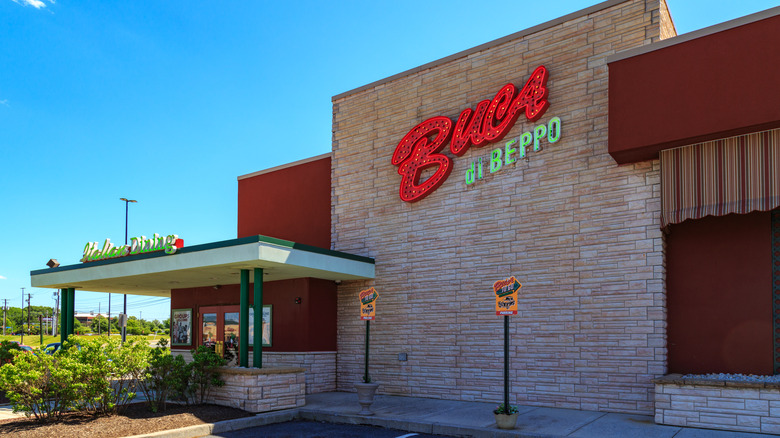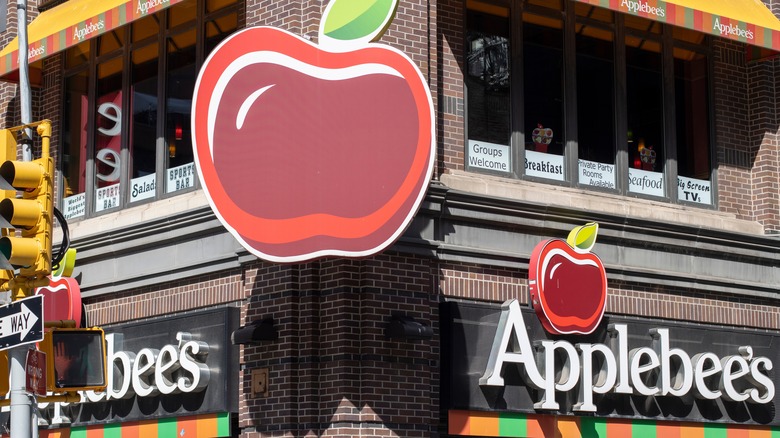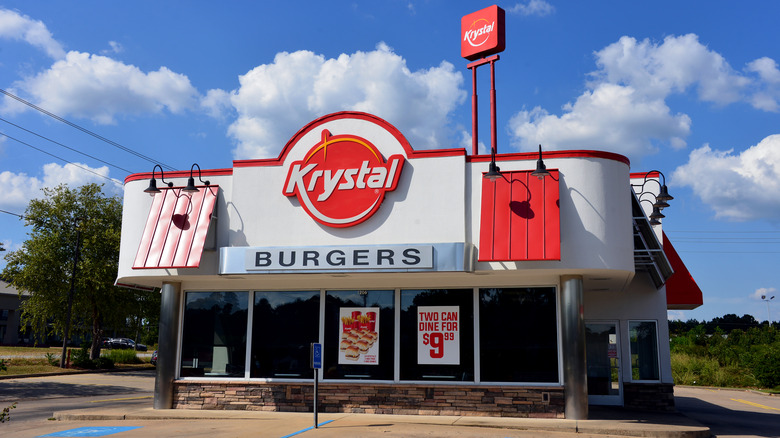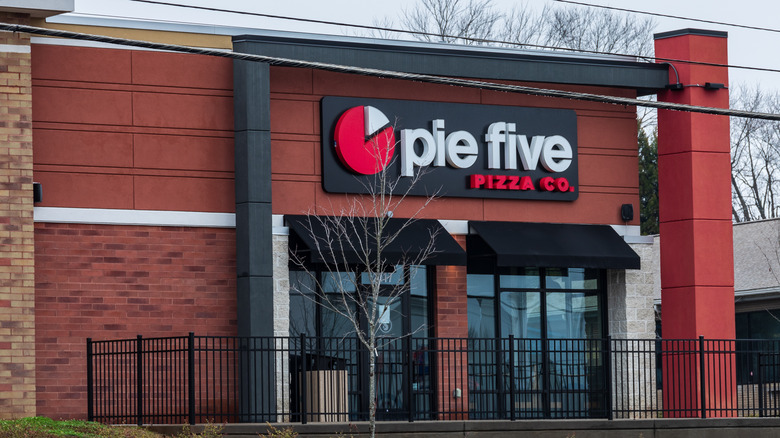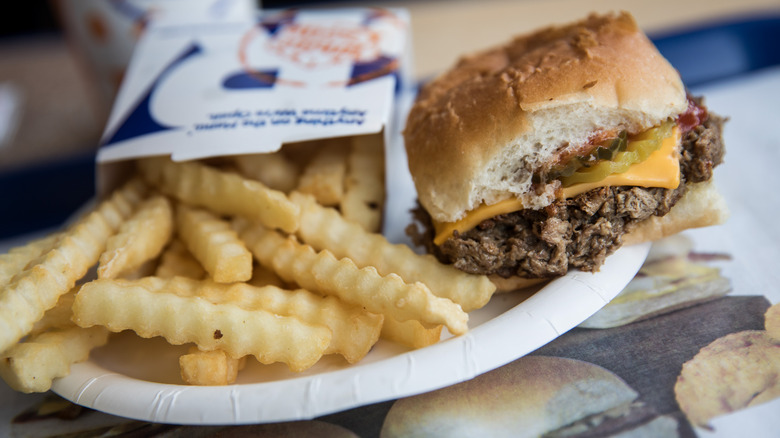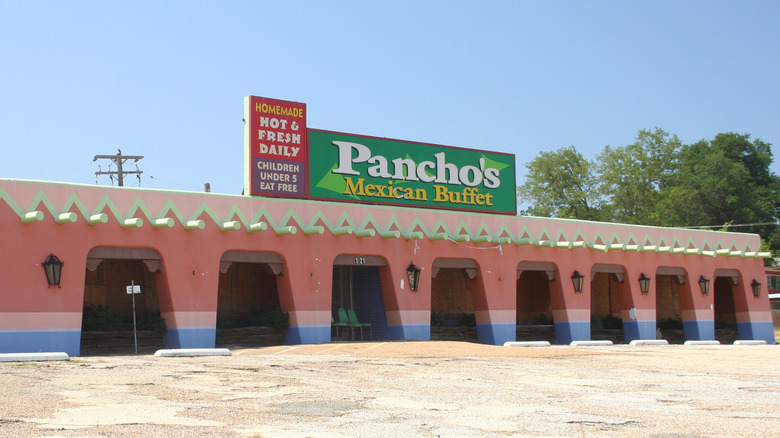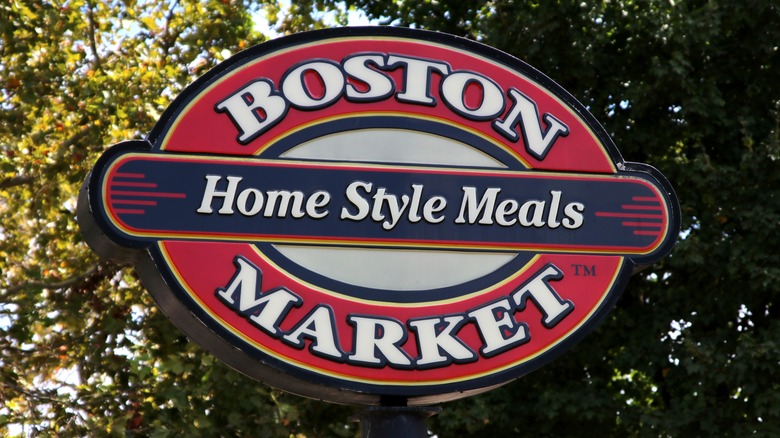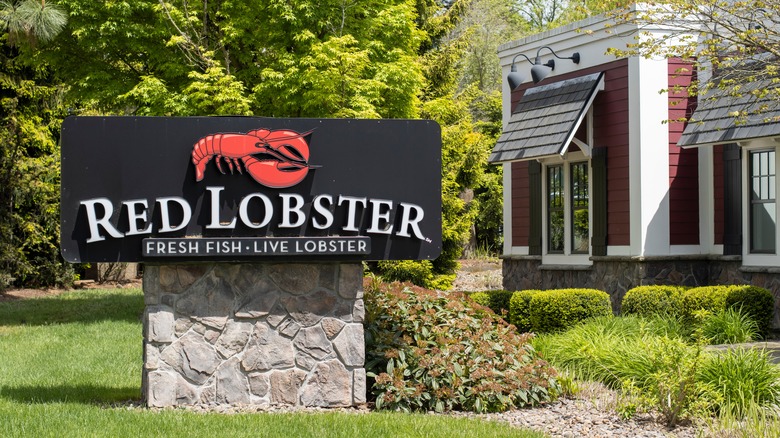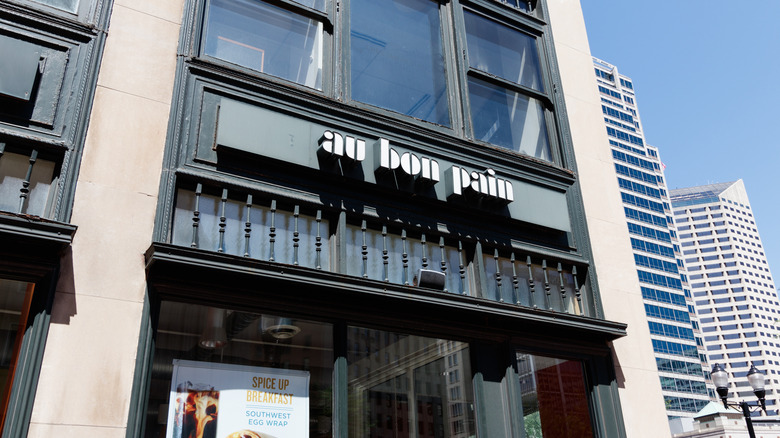12 Chain Restaurants That Might Sadly Disappear In 2024
It's no big secret: Times are tough. It seems like money is tighter than ever been, so it's hardly any surprise that folks have had to cut back on some of their favorite activities, like eating out. Throughout 2023, the restaurant industry faced continual challenges, with notably lower traffic throughout the third quarter of the year and full-service restaurants struggling most of all, according to analysis from Placer.ai. This lower traffic has had a big knock-on effect for 2024, and it's not just small businesses that are having difficulty: Some of the largest, most well-known chain restaurants are feeling the heat, so much so that they risk disappearing entirely.
The size of some of these restaurants might surprise you, too. Chains that were once giants of the industry, like Applebee's and White Castle, are facing harder times than they've ever seen, with legal challenges hampering the growth and multiple locations closing up shop. Elsewhere, chains have been hit by bankruptcy, and in a post-COVID landscape have been unable to find their feet again. Whatever the reasons, we're here to highlight those beloved restaurants that might be seeing their final days.
1. Buca Di Beppo
Buca Di Beppo is in trouble, folks. The Italian-American restaurant chain has been a familiar name in the chain restaurant world since its debut in 1993, and by 2016 it had almost 100 locations across the United States and the United Kingdom. Unfortunately, since then it's faced a slow decline in fortunes and restaurant numbers, and has accrued a significant amount of debt along the way.
This all came to a head in August 2024, when Buca Di Beppo filed for Chapter 11 bankruptcy. It was announced that the chain owed its dozens of creditors tens of millions of dollars, but the company only had up to $50,000 in assets, presenting a significant problem for its recovery. Along with its bankruptcy, it announced that it was closing 18 of its restaurants across the country. While the company framed its closures as part of its strategy to create more growth and stated that it was planning on opening another location, it's difficult to see how it can cling on in an environment of ever-increasing food prices and labor costs.
2. Applebee's
There was a time when it felt like Applebee's ruled the world. This restaurant was (and for a lot of people, still is) the one-stop-shop for burgers, chicken, pasta, salads — you name it, the menu had it. Somewhere along the way, though, things started to go wrong, and in recent years Applebee's has been plagued by restaurant closures. The chain has closed roughly 300 locations since 2017, and it had originally earmarked 2023 as a growth year. That didn't quite work out, though. The after-effects of COVID led to a stall in growth, despite various attempts to keep the brand up to date, including rebranding its music.
Fast-forward to 2024, and things are looking even more bleak. The restaurant saw a drop of almost 5% in its year-on-year comparable same-restaurant trading in Q1 of 2024, according to Today. This has been paired with even more restaurant closures, with up to 35 more Applebee's set to close as of May this year. While Applebee's president Tony Moralejo tried to steady the ship by expressing confidence in the brand's long-term growth plan, it's clear that the chain's in trouble, and the waters could get even rockier in the rest of the year.
3. Krystal
Krystal needs a win, y'all. The burger chain (which also serves breakfast) has been struggling pretty significantly over the last few years, and for almost a decade it's been plagued with diminishing returns. By the end of 2022, the brand had 287 locations, a reduction of over 20% from five years previous, according to Restaurant Business Online. Amidst all of this, the brand put in a bankruptcy claim in January 2020, following a chaotic period of changing senior management and cutbacks. When you consider that was before the COVID-19 pandemic hit, which made it even more difficult for businesses to survive, things don't look so rosy.
Unfortunately, things haven't been as rosy recently, either. In August 2023, Krystal announced that it would be selling even more of its burger joints in a bid to spur more growth. As yet, there doesn't seem to be any indication that this plan has worked — and while new Krystal restaurants have popped up around the country in 2024, such as one in North Carolina, it's clear that the chain is continuing to contrast elsewhere. We wouldn't be surprised if it ended 2024 with some sad news.
4. Pie Five Pizza
Pie Five Pizza may be, if you'll excuse the pun, a flash in the pan pizza joint (pan pizza, get it? Yeah? Okay, great). The chain is an offshoot of Pizza Inn, a buffet pizza restaurant that saw a gap in the market for an "express" concept that could supply diners with fresh pies in less than five minutes. When it appeared roughly a decade ago, things appeared to go well: Pie Five Pizza expanded rapidly, with the business having a clear appeal in locations where people just wanted pizza without having to wait around, like airports and other places of transit.
However, that initial boost was followed by a slow, painful decline. From 2018 to 2023, Pie Five Pizza closed two-thirds of its locations, with the end of June 2023 seeing it shrink to just 27 outlets. By the end of the year, it was announced that Pizza Inn would start operating out of Pie Five locations in 2024, signaling that the express brand could be on the way out. This was coupled with closures of Pie Five locations across the country, with the restaurant closing its last Kansas City unit in June 2024. The future doesn't look so bright for this brand.
5. White Castle
It's hard to consider that a restaurant with such a large cultural impact as White Castle could just disappear. However, with the challenges that it's faced over the last few years, we wouldn't be surprised if 2024 is when it will take its final breath. In 2023, White Castle suffered an almighty blow in the form of a court ruling that stated that it could have breached biometric identification laws in Illinois. This arrived when a manager of an Illinois branch sued the brand after stating that she wasn't asked permission for her fingerprint data to be used and taken by the company until long after the technology was introduced.
The court ruling was pretty brutal, with the potential costs to White Castle being absolutely enormous: It was stated that it could have to pay out up to $17 billion. Luckily for White Castle, the final settlement was much lower, with the brand paying $9.4 million in compensation. This hit to the chain's reputation, however, has been coupled by an overall shrinking of the brand, with its restaurant count reducing over the past few years. It isn't helped by the fact that White Castle's menu has remained pretty unchanging for a while, and is packed with unhealthy things, which doesn't exactly make it appealing to a fast food landscape that is now more focused on healthy eating. If this year was the year that it packed it all in, we wouldn't be surprised.
6. Pancho's Mexican Buffet
If you want a hit of nostalgia, head to Pancho's Mexican Buffet — while you still can, that is. There was a time when this chain was big business in the Southern and Southeastern states. During the '80s and '90s, the El Paso-born brand boasted over 50 locations that were concentrated in Oklahoma, Texas, and Louisiana.
However, since its birth in 1958 and its heyday a few decades after, things have gone downhill. Over the 21st century, the size of Pancho's Mexican Buffet has reduced drastically. The brand suffered from poor stock performance and dwindling profits, and although it tried to tweak its output to incorporate an Express element into its restaurants, that didn't prevent its locations from closing up shop. As of 2024, there are just two Pancho's Mexican Buffet locations operating in its birthplace of Texas: One in the Arlington area, and one in the Fort Worth area. Its branding and decor now seems to more closely resemble a neighborhood joint, but we wouldn't be too shocked if it didn't see out the rest of the year.
7. Boston Market
Boston Market's fall from grace has been pretty epic. At one time, the restaurant had over 1,100 locations across the country; while Boston Market was first called something else, you couldn't escape this restaurant, which had expanded rapidly in the decade after it was invented in 1985. This rapid expansion, however, was the start of its problems. When Boston Market tried to grow into international spaces, its debt caught up with it, and the chain filed for bankruptcy in 1998.
From there, Boston Market has changed hands several times and has been set back by lawsuits. Along the way, its number of locations has also reduced. What was once a dominant restaurant chain morphed into a tiny outfit. In March 2024, Restaurant Business News reported that the company had dwindled down to just 27 locations, however, in an interview with Today, this number was disputed by Jay Pandya, owner of Rohan Group, which purchased Boston Market in 2020. The company has also lost its headquarters, and a second bankruptcy claim was denied, meaning that the restaurant has no court protection from the people it owes money to. This is a restaurant that is seriously on the brink, and if it announced that it was disappearing by the end of 2024, it likely wouldn't shock anyone.
8. Piccadilly Cafeteria
When Piccadilly Cafeteria was founded in 1944, it seemed to represent exactly what customers were looking for at the time: homestyle meals made with love and served at a reasonable price. This recipe for success led to Piccadilly Cafeterias popping up across more than a dozen states, and at one time it had hundreds of restaurants, particularly throughout the Southeast and mid-Atlantic regions. However, things started to take a turn for the worst in 2003, when the chain filed for bankruptcy for the first time. Although it managed to keep going despite this, it filed another bankruptcy claim in 2012 when its number of restaurants had reduced from the hundreds to roughly 80.
Since then, Piccadilly Cafeteria has struggled to keep up in a market that arguably values new flavors and world cuisine. As palettes expanded, Piccadilly Cafeteria's business shrank. Its restaurants slowly but surely started to close across the country, with its Jacksonville branch, which was in business for half a century, shutting up shop in 2023. There are currently just a few dozen branches remaining across the country, and it could just be a matter of time before they close for good.
9. Red Lobster
On the surface, it looks like Red Lobster's doing pretty well. The chain has hundreds of restaurants nationwide, and it still lays claim to being one of the most prominent chain restaurants out there to get seafood. It regularly updates its menu too, recently unveiling its new Crabfest items, showing that it still cares about its output. So what's the issue? Well, under the surface, Red Lobster is seriously struggling — and it's uncertain as to whether it'll come back up for air. In May 2024, the chain filed for bankruptcy. Despite bringing in $2 billion in annual sales, the company let the world know that they were over $1 billion in debt, and had a mere $30 million in the bank.
Its bankruptcy claim coincided with a massive closure of Red Lobster restaurants across the country, with almost 100 locations across 27 states closing up shop. The chain has had interest from investors who are hoping to save it, but in a situation as high-stakes and fluid as this, it may not be as simple as buying the chain out. Whether Red Lobster can turn it around in time is anybody's guess, but with such a cash deficit, it would need a hero to pluck it from doom.
10. Ruby Tuesday
The COVID-19 pandemic had an enormous impact on the food industry, and it wasn't just small businesses that suffered. Some of the biggest, most well-known brands in the country were also affected by people's inability to get out and eat in a restaurant — especially if they hadn't pivoted particularly successfully to offering speedy meals or takeout-friendly options. This was the case with Ruby Tuesday, the casual dining chain that's been struggling since the 1980s, but that has faced particular challenges recently. When the pandemic hit, Ruby Tuesday's business took a nosedive, with many of its temporary closures turning to permanent shutterings. The brand continued to lose money, and in 2020, it filed for bankruptcy.
This bankruptcy coincided with an enormous loss of physical stores. In 2019, Ruby Tuesday had over 450 locations (which is already a smaller number than the just a few years prior), but after the bankruptcy process, it was left with just 209 restaurants. Ruby Tuesday made a considered effort to shift its business model to a more delivery-focused service. However, its problems have continued into 2024, with restaurants continuing to shut down, some even due to failing health inspections.
11. Au Bon Pain
Has Au Bon Pain been a flash in the pan? (Sorry, we couldn't resist). While the French café chain has been around since 1978, its wide scale expansion was fairly recent. In the early 2010s, Au Bon Pain operated a peak of more than 200 locations across the country, with a particular concentration in the New York area. Throughout the years, however, its ownership has been pretty flexible, and the company changed hands several times before eventually being sold to Ampex Brands in 2022.
This sale coincided with a refocus for Au Bon Pain, which lost almost half of its physical locations in a decade and had suffered losses in sales, which was sped up by the COVID-19 pandemic. The restaurant closures throughout the period hit Au Bon Pain much harder than other chains due to its trading locations: The chain was a fixture at places like airports and college campuses, with the former becoming less busy due to less travel, and the latter affected by a switch to online learning. While the plan for Au Bon Pain was to pivot to a growth model with its takeover by Ampex, its stores have continued to close throughout 2024, and it looks as though it's still struggling.
12. Rax Roast Beef
Stepping into a Rax Roast Beef — if you can find one, that is — is like stepping back in time. Once upon a time, Rax Roast Beef was everywhere. The chain once had more than 500 locations, and in the 1980s it was the place to go for hot sandwiches, as well as comforting staples like baked potatoes and barbecue beef. It even had a salad bar, an idea that it largely pioneered.
Things started to really go wrong, however, in the 1990s. In 1992, Rax announced a new ad campaign with a character called Mr. Delicious. The idea behind the character and campaign was that it would mark Rax out as a classy, upscale joint to have your dinner. Unfortunately, customers failed to respond to the ill-fated, misguided figure, and just three months after the campaign was announced, Rax filed for bankruptcy. From there, it never really recovered, changing hands and losing locations at the speed of light. Fast-forward to 2024, and Rax has just a handful of locations left.

